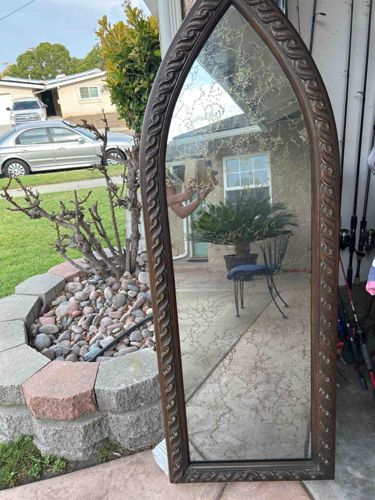
Gothic Revival Arched Floor Mirror
This is a large, floor-standing or leaning mirror with a distinct Gothic Revival aesthetic. Its primary feature is the arched top, typical of lancet-style windows found in Gothic architecture. The frame appears to be crafted from wood, likely a dark stained hard wood, finished to mimic an aged or antique bronze appearance. The entire frame is heavily carved with a repeating, swirling, and textured pattern resembling acanthus leaves or a braided rope motif, creating a rich, textural border around the reflective surface. This intricate carving is present along the entire length of the frame, from the rectangular base to the pointed arch. The mirror itself exhibits significant desilvering or foxing, particularly visible as an extensive, mottled, and web-like pattern across the entire reflective surface. This suggests considerable age or exposure to moisture, leading to the deterioration of the silvering on the back of the glass. While this is a condition issue, for some, it might enhance an antique or 'shabby chic' appeal. There are no immediately obvious chips or cracks in the glass, but the extent of the foxing obscures the view significantly. The overall construction appears solid and substantial, indicating a higher quality piece. There are no visible maker's marks or signatures from the provided images. Given the style and the degree of desilvering, the mirror likely dates from the late 19th to early 20th century, or it could be a more contemporary piece intentionally distressed to achieve an aged look.
AI-Generated Appraisal Disclaimer
Estimated Value
$300-600
Basic Information
Category
Home Decor
Appraised On
November 28, 2025
Estimated Value
$300-600
Item Description
This is a large, floor-standing or leaning mirror with a distinct Gothic Revival aesthetic. Its primary feature is the arched top, typical of lancet-style windows found in Gothic architecture. The frame appears to be crafted from wood, likely a dark stained hard wood, finished to mimic an aged or antique bronze appearance. The entire frame is heavily carved with a repeating, swirling, and textured pattern resembling acanthus leaves or a braided rope motif, creating a rich, textural border around the reflective surface. This intricate carving is present along the entire length of the frame, from the rectangular base to the pointed arch. The mirror itself exhibits significant desilvering or foxing, particularly visible as an extensive, mottled, and web-like pattern across the entire reflective surface. This suggests considerable age or exposure to moisture, leading to the deterioration of the silvering on the back of the glass. While this is a condition issue, for some, it might enhance an antique or 'shabby chic' appeal. There are no immediately obvious chips or cracks in the glass, but the extent of the foxing obscures the view significantly. The overall construction appears solid and substantial, indicating a higher quality piece. There are no visible maker's marks or signatures from the provided images. Given the style and the degree of desilvering, the mirror likely dates from the late 19th to early 20th century, or it could be a more contemporary piece intentionally distressed to achieve an aged look.
Get Your Items Appraised
Instant estimates of your treasures with AI-powered instant appraisals